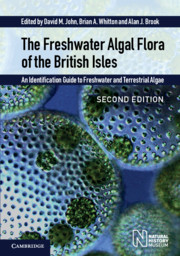 The Freshwater Algal Flora of the British Isles
The Freshwater Algal Flora of the British Isles Book contents
- Frontmatter
- Contents
- The online material (formerly provided in DVD format)
- List of Contributors
- Foreword
- Preface
- Acknowledgements
- Introduction
- Distribution and Ecology
- History of Freshwater Algal Studies in the British Isles
- Field Methods
- Laboratory Methods
- Water Framework Directive
- Cultures of British Freshwater Algae
- Classification
- Key to phyla
- Cyanobacteria (Cyanophyta)
- Phylum Rhodophyta (Red Algae)
- Phylum Euglenophyta (Euglenoids)
- Phylum Cryptophyta (Cryptomonads)
- Phylum Dinophyta (Dinoflagellates)
- Phylum Raphidophyta
- Phylum Haptophyta (Prymnesiophyta)
- Phylum Chrysophyta (Golden Algae)
- Phylum Xanthophyta (Tribophyta) (Yellow-Green Algae)
- Phylum Eustigmatophyta
- Phylum Bacillariophyta (Diatoms)
- Phylum Phaeophyta (Brown Algae)
- Primitive Green Algae (‘PRASINOPHYTA’)
- Phylum Chlorophyta (Green Algae)
- Phylum Glaucophyta
- Glossary
- Standard Form of Authors of Algal Names
- Sources of Illustrations or Material
- References
- Taxonomic Index
- Subject Index
- Plate Saction
- Miscellaneous Endmatter
- Miscellaneous Endmatter
Cyanobacteria (Cyanophyta)
Published online by Cambridge University Press: 12 January 2024
- Frontmatter
- Contents
- The online material (formerly provided in DVD format)
- List of Contributors
- Foreword
- Preface
- Acknowledgements
- Introduction
- Distribution and Ecology
- History of Freshwater Algal Studies in the British Isles
- Field Methods
- Laboratory Methods
- Water Framework Directive
- Cultures of British Freshwater Algae
- Classification
- Key to phyla
- Cyanobacteria (Cyanophyta)
- Phylum Rhodophyta (Red Algae)
- Phylum Euglenophyta (Euglenoids)
- Phylum Cryptophyta (Cryptomonads)
- Phylum Dinophyta (Dinoflagellates)
- Phylum Raphidophyta
- Phylum Haptophyta (Prymnesiophyta)
- Phylum Chrysophyta (Golden Algae)
- Phylum Xanthophyta (Tribophyta) (Yellow-Green Algae)
- Phylum Eustigmatophyta
- Phylum Bacillariophyta (Diatoms)
- Phylum Phaeophyta (Brown Algae)
- Primitive Green Algae (‘PRASINOPHYTA’)
- Phylum Chlorophyta (Green Algae)
- Phylum Glaucophyta
- Glossary
- Standard Form of Authors of Algal Names
- Sources of Illustrations or Material
- References
- Taxonomic Index
- Subject Index
- Plate Saction
- Miscellaneous Endmatter
- Miscellaneous Endmatter
Summary
Introduction
The blue-green algae (Cyanobacteria) are unicellular or filamentous organisms that sometimes form structures recognizable with the naked eye, but usually require a microscope for identification. They differ from all other groups in this Flora in that they are prokaryotes: their cell contents are not differentiated into membrane-bound structures such as the nucleus, chloroplasts and mitochondria. The popular name for the group, blue-green algae, comes from the colour of the cells seen under the microscope. The photosynthetic pigments in the membranes inside the cells contain chlorophyll a, which gives a green colour, but almost all species can form the blue pigment, phycocyanin, under some conditions and some also forma red pigment, phycoerythrin. The cells therefore often appear blue-green, but sometimes shades of purple, when all three pigments are present. Visually obvious growths are also often blue-green, but sometimes they are brownish, purple or orange. This is because many species have a sheath around individual cells or the whole filament and this sheath is often golden or dark brown, or sometimes a shade of red.
Many blue-green algae are easy for someone without specialist knowledge to recognize under the microscope to the genus or even the species. However, the group has gained a reputation for being difficult to identify reliably. This is partly because some species are morphologically highly variable and in some cases groups of species which appear distinct in one place all tend to merge with each other elsewhere. However, there are also problems due to the different approaches which have been used to name the organisms. The most important difference is between the botanical and bacteriological approaches. The bluegreens are anomalous in that they have been treated by some authors under the conventions of the International Code of Botanical Nomenclature, while others under the International Code of Bacteriological Nomenclature.
The present account includes marine as well as freshwater and terrestrial species. Some species occur in both types of environment: many freshwater species extend into brackish environments and a few marine species also extend into brackish environments. Morphologically similar forms occurring in non-marine and marine environments have sometimes been given different names and in other cases the same name. At least with the current state of knowledge for the British Isles, there are relatively few strictly marine blue-green algae, so it seems best to provide an account of the whole Flora.
- Type
- Chapter
- Information
- The Freshwater Algal Flora of the British IslesAn Identification Guide to Freshwater and Terrestrial Algae, pp. 31 - 158Publisher: Cambridge University PressPrint publication year: 2021
- 2
- Cited by
